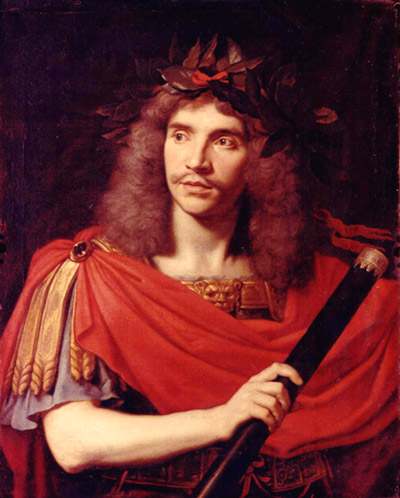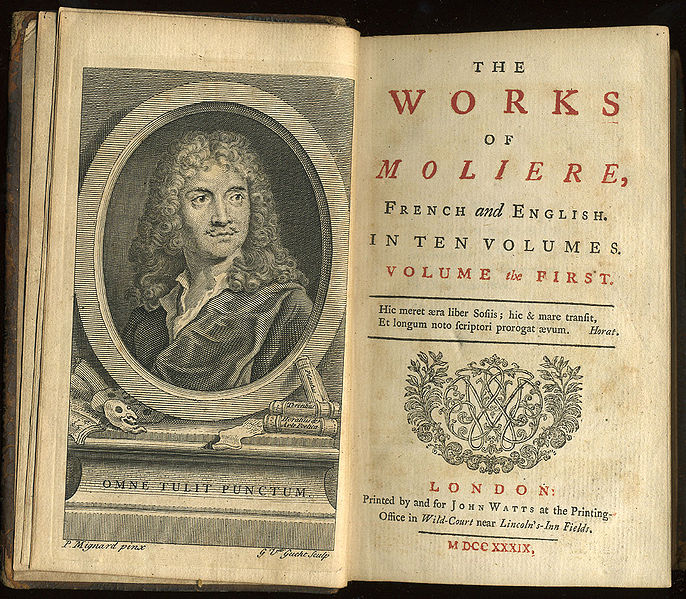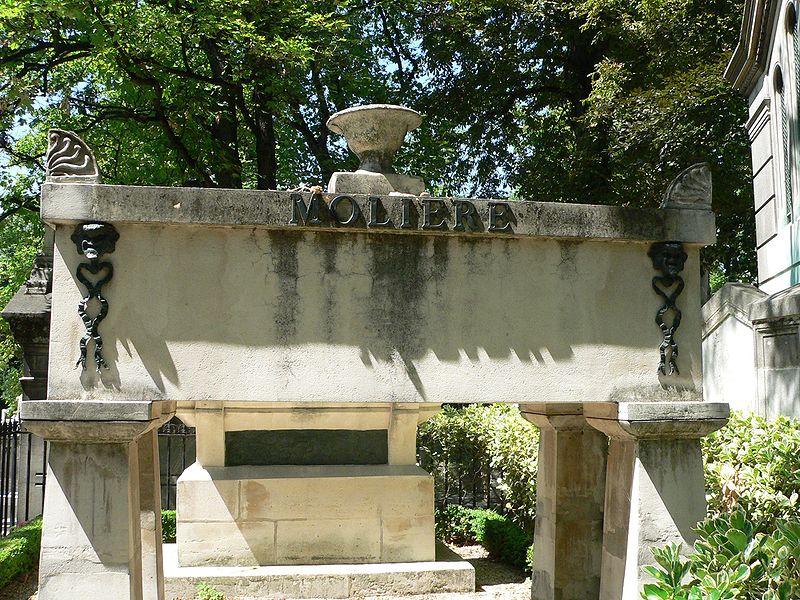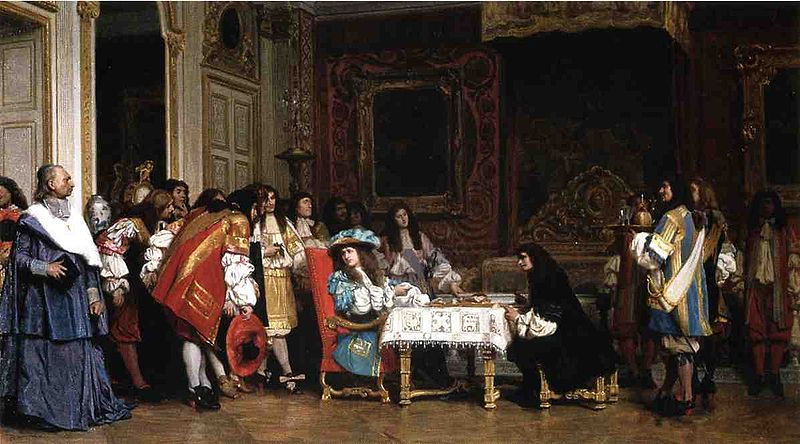<Back to Index>
- Mathematician Sofia Vasilyevna Kovalevskaya, 1850
- Playwright Jean Baptiste Poquelin (Molière), 1622
- 2nd President of Egypt Gamal Abdel Nasser, 1918
PAGE SPONSOR

Jean-Baptiste Poquelin, mostly known by his stage name Molière, (January 15, 1622 – February 17, 1673) was a French playwright and actor who is considered one of the greatest masters of comedy in Western literature. Among Molière's best-known dramas are Le Misanthrope (The Misanthrope), L'École des femmes (The School for Wives), Tartuffe ou L'Imposteur (Tartuffe or the Hypocrite), L'Avare ou L'École du mensonge (The Miser), Le Malade imaginaire (The Imaginary Invalid), and Le Bourgeois gentilhomme (The Bourgeois Gentleman).
Born into a prosperous family and having studied at the Collège de Clermont (now Lycée Louis-le-Grand), Molière was well suited to begin a life in the theatre. Thirteen years as an itinerant actor helped him polish his comic abilities while he began writing, combining Commedia dell'Arte elements with the more refined French comedy. Through the patronage of a few aristocrats, including Philippe I, Duke of Orléans -- the brother of Louis XIV -- Molière procured a commanding performance before the King at the Louvre. Performing a classic play by Pierre Corneille and a farce of his own, Le Docteur amoureux (The Doctor in Love), Molière was granted the use of salle du Petit-Bourbon at the Louvre, a spacious room appointed for theatrical performances. Later, Molière was granted the use of the Palais-Royal. In both locations he found success among the Parisians with plays such as Les Précieuses ridicules (The Affected Ladies), L'École des maris (The School for Husbands) and L'École des femmes (The School for Wives). This royal favor brought a royal pension to his troupe and the title "Troupe du Roi" (The King's Troupe). Molière continued as the official author of court entertainments. Though
he received the adulation of the court and Parisians, Molière's
satires attracted criticisms from moralists and the Roman Catholic Church. Tartuffe ou L'Imposteur (Tartuffe or the Hypocrite) and its attack on religious hypocrisy roundly received condemnations from the Church, while Dom Juan was
banned from performance. Molière's hard work in so many
theatrical capacities began to take its toll on his health and, by
1667, he was forced to take a break from the stage. In 1673, during a
production of his final play, Le Malade imaginaire (The Imaginary Invalid), Molière, who suffered from pulmonary tuberculosis, was seized by a coughing fit and a haemorrhage while playing the hypochondriac Argan. He finished the performance but collapsed again and died a few hours later. Molière was born in Paris, the son of Jean Poquelin and Marie Cressé, the daughter of a prosperous bourgeois family. Jean-Baptiste
Poquelin lost his mother at the age of 10 and doesn't seem to have been
particularly close to his father. After his mother's death, he lived
with his father above the Pavilion de Singes on the rue Saint-Honoré,
an affluent area of Paris. It is likely that his education commenced
with studies in a Parisian elementary school; this was followed with
his enrollment in the prestigious Jesuit Collège de Clermont, where he completed his studies in a strict academic environment. In 1631 Jean Poquelin purchased from the court of Louis XIII the
posts of "valet de chambre ordinaire et tapissier du Roi" ("valet in
ordinary of the King's chamber and keeper of carpets and upholstery").
His son assumed the same posts in 1641. The
title required only three months' work and an initial cost of 1,200
livres; the title paid 300 livres a year and provided a number of
lucrative contracts. Poquelin also studied as a provincial lawyer some
time around 1642, probably in Orléans,
but it is not documented that he ever qualified. So far he had followed
his father's plans, which had served him well; he had mingled with
nobility at the Collège de Clermont and seemed destined for a
career in office. In
June 1643, when Molière was 21, he decided to abandon his social
class and pursue a career on the stage. Taking leave of his father, he
joined the beautiful Madeleine Béjart, with whom he had crossed paths before, and founded L'Illustre Théâtre with 630 livres. They were later joined by Madeleine's brother and sister.
The
new theatre troupe became bankrupt in 1645. Molière had become
head of the troupe, due in part, perhaps, to his acting prowess and his
legal training. However, the troupe had acquired large debts, mostly
for the rent of the theatre (a court for jeu de paume),
for which they owed 2000 livres. Historians differ as to whether his
father or the lover of a member of his troupe paid his debts; either
way, after a 24-hour stint in prison he returned to the acting circuit.
It was at this time that he began to use the pseudonym Molière, possibly inspired by a small village of the same name in the Midi near Le Vigan.
It was also likely that he changed his name to spare his father the
shame of having an actor in the family (actors, although no longer
vilified by the state under Louis XIV, were still not allowed to be
buried in sacred ground). After his imprisonment, he and Madeleine began a theatrical circuit of the provinces with a new theatre troupe; this life was to last about 12 years, during which he initially played in the company of Charles Dufresne, and subsequently created a company of his own, which had sufficient success and obtained the patronage of Philippe I, Duke of Orléans. Few plays survive from this period. The most noteworthy are L'Étourdi, ou le Contretemps and Le Docteur amoureux; with these two plays, Molière moved away from the heavy influence of the Italian improvisational Commedia dell'arte, and displayed his talent for mockery. In the course of his travels he met Armand, Prince of Conti, the governor of Languedoc, who became his patron, and named his company after him. This friendship later ended when Conti, having contracted syphilis from
a prostitute, attempted to cure himself by reconciling himself with
religion. Conti's religious advisor counseled him against maintaining
actors and encouraged him to join Molière's enemies in the Parti des Dévots and the Compagnie de Saint Sacrement. In Lyon, Mademoiselle Duparc, known as Marquise, joined the company. Marquise was courted, in vain, by Pierre Corneille and later became the lover of Jean Racine. Racine offered Molière his tragedy Théagène et Chariclée (one of the first works he wrote after he had abandoned his theology studies),
but Molière would not perform it, though he encouraged Racine to
pursue his artistic career. It is said that soon thereafter
Molière became angry with Racine when he was told that he had
secretly presented his tragedy to the company of the Hôtel de Bourgogne as well. Molière was forced to reach Paris in stages, staying outside for a few weeks in order to inveigle himself
with society gentlemen and allow his reputation to feed in to Paris.
Molière reached Paris in 1658 and performed in front of the King
at the Louvre (then for rent as a theatre) in Corneille's tragedy Nicomède and in the farce Le Docteur amoureux (The Doctor in Love), with some success. He was awarded the title of Troupe de Monsieur (Monsieur being the honorific for the king's brother Philippe I, Duke of Orléans) and with the help of Monsieur, his company joined a famous Italian Commedia dell'arte company. He became firmly established at their theatre, Petit-Bourbon, where on November 18, 1659, he performed the premiere of Les Précieuses ridicules (The Affected Young Ladies). Les Précieuses ridicules was
the first of Molière's many attempts to satirize certain
societal mannerisms and affectations then common in France. It is
widely accepted that the plot was based on Samuel Chappuzeau's Le Cercle des femmes of 1656. He primarily mocks the Académie Française,
a group created by Richelieu under a royal patent to establish the
rules of the fledgling French theater. The Académie preached
unity of time, action, and styles of verse. Molière is often
associated with the claim that comedy castigat ridendo mores or
"criticizes customs through humor," a phrase in fact coined by his
contemporary Jean de Santeuil and sometimes mistaken for a classical Latin proverb. Despite his own preference for tragedy, which he had tried to further with the Illustre Theatre, Molière became famous for his farces,
which were generally in one act and performed after the tragedy. Some
of these farces were only partly written, and were played in the style
of Commedia dell'arte with improvisation over a canovaccio.
He also wrote two comedies in verse, but these were less successful and
are generally considered less significant. Later in life Molière
concentrated on writing musical comedies, in which the drama is
interrupted by songs and/or dances. Les précieuses ridicules won Molière the attention and the criticism of many, but it was not a popular success. He then asked his Italian partner Tiberio Fiorelli, famous for his character of Scaramouche, to teach him the techniques of Commedia dell'arte. His 1660 play Sganarelle, ou Le Cocu imaginaire (The Imaginary Cuckold)
seems to be a tribute both to Commedia dell'arte and to his teacher.
Its theme of marital relationships dramatizes Molière's
pessimistic views on the falsity inherent in human relationships. This
view is also evident in his later works, and was a source of
inspiration for many later authors, including (in a different field and
with different effect) Luigi Pirandello.
It describes a kind of round dance where two couples believe that each
of their partners has been betrayed by the other's and is the first in
Molière's 'Jealousy series' which includes Dom Garcie de Navarre, L'École des maris and L'École des femmes. In
1661, in order to please his patron, Monsieur, who was so enthralled
with entertainment and art that he was soon excluded from state affairs, Molière wrote and played Dom Garcie de Navarre ou Le Prince jaloux (The Jealous Prince), a heroic comedy derived from a work of Cicognini's. Two other comedies of the same year were the successful L'École des maris (The School for Husbands) and Les Fâcheux, subtitled Comédie faite pour les divertissements du Roi (a comedy for the King's amusements) because it was performed during a series of parties that Nicolas Fouquet gave in honor of the sovereign. These entertainments led Jean-Baptiste Colbert to demand the arrest of Fouquet for wasting public money, and he was condemned to life imprisonment. In 1662 Molière moved to the grander Théâtre du Palais-Royal,
still with his Italian partners, and married Armande, whom he believed
to be the sister of Madeleine. She may have instead been her
illegitimate daughter with the Duke of Modena. The same year he premiered L'École des femmes (The School for Wives),
subsequently regarded as a masterpiece. It poked fun at the limited
education that was given to daughters of rich families, and reflected
Molière's own marriage. Both this work and his marriage
attracted much criticism. The play sparked the protest called the
"Quarrel of L'École des femmes." On the artistic side he
responded with two lesser-known works: La Critique de "L'École des femmes",
in which he imagined the spectators of his previous work attending it.
This perhaps needs some explanation: the piece mocks the people who had
criticised L'École des femmes by
showing them at dinner after watching the play; it addresses all the
criticism raised about the piece by presenting the critics' arguments and then dismissing them. This was the so-called Guerre comique (War of Comedy), in which the opposite side was taken by writers like Donneau de Visé, Edmé Boursault, and Montfleury. But more serious opposition was brewing, focusing on Molière's politics and his personal life. A so-called parti des Dévots arose in French high society, who protested against Molière's excessive "realism"
and irreverence, which were causing some embarrassment. These people
accused Molière of having married his daughter. The Prince of
Conti, once Molière's friend, joined them. Molière had
other enemies, too, among them the Jansenists and some traditional authors. However, the king expressed his solidarity with the author, granting him a pension and agreeing to be the godfather of Molière's first son. Boileau also supported him through statements that he included in his Art poétique. Molière's friendship with Jean-Baptiste Lully influenced him towards writing his Le Mariage forcé and La Princesse d'Élide (subtitled as Comédie galante mêlée de musique et d'entrées de ballet), written for royal "divertissements" at the Palace of Versailles. Tartuffe, ou L'Imposteur was also performed at Versailles, in 1664, and created the greatest scandal of
Molière's artistic career. Its depiction of the hypocrisy of the
dominant classes was taken as an outrage and violently contested. It
also aroused the wrath of the Jansenists and the play was banned. Molière
was always careful not to attack the institution of monarchy. He earned
a position as one of the king's favorites and enjoyed his protection
from the attacks of the court. The king allegedly suggested that
Molière suspend performances of Tartuffe, and the author rapidly wrote Don Juan ou le Festin de Pierre to replace it. It was a strange work, derived from a work by Tirso de Molina and rendered in a prose that
still seems modern today. It describes the story of an atheist who
becomes a religious hypocrite and for this is punished by God. This
work too was quickly suspended. The king, demonstrating his protection
once again, became the new official sponsor of Molière's troupe. With music by Lully, Molière presented L'Amour médecin (Love Doctor or Medical Love).
Subtitles on this occasion reported that the work was given "par ordre
du Roi" (by order of the king), and this work was received much more
warmly than its predecessors. In 1666, Le Misanthrope was
produced. It is now widely regarded as Molière's most refined
masterpiece, the one with the highest moral content, but it was little
appreciated at its time. It caused the "conversion" of Donneau de
Visé, who became fond of his theater. But it was a commercial
flop, forcing Molière to immediately write Le médecin malgré lui (The Doctor Despite Himself),
a satire against the official sciences. This was a success despite a
moral treatise by the Prince of Conti, criticizing the theater in
general and Molière's in particular. In several of his plays,
Molière depicted the physicians of his day as pompous
individuals who speak (poor) Latin to impress others with false
erudition, and know only clysters and bleedings as (ineffective) remedies. After the Mélicerte and the Pastorale comique, he tried again to perform a revised Tartuffe in 1667, this time with the name of Panulphe or L'Imposteur. As soon as the King left Paris for a tour, Lamoignon and the archibishop banned the play. The King finally imposed respect for Tartuffe a few years later, after he had gained more power over the clergy. Molière, now ill, wrote less. Le Sicilien ou L'Amour peintre was written for festivities at the castle of Saint-Germain, and was followed in 1668 by Amphitryon, inspired both by Plautus'
work of the same name and Jean Rotrou's successful reconfiguration of
the drama. With some conjecture, Molière's play can be seen to
allude to the love affairs of Louis XIV, then king of France. George Dandin, ou Le mari confondu (The Confounded Husband) was little appreciated, but success returned with L'Avare (The Miser), now very well known. With Lully he again used music for Monsieur de Pourceaugnac, for Les Amants magnifiques, and finally for Le Bourgeois gentilhomme (The Middle Class Gentleman),
another of his masterpieces. It is claimed to be particularly directed
against Colbert, the minister who had condemned his old patron Fouquet.
The collaboration with Lully ended with a tragédie et ballet, Psyché, written in collaboration with Pierre Corneille and Philippe Quinault. In
1672, Madeleine Béjart died, and Molière suffered from
this loss and from the worsening of his own illness. Nevertheless, he
wrote a successful Les Fourberies de Scapin (Scapin's Schemings), a farce and a comedy in five acts. His following play, La Comtesse d'Escarbagnas, is considered one of his lesser works. Les Femmes savantes (The Learned Ladies)
of 1672 is considered one of Molière's masterpieces. It was born
from the termination of the legal use of music in theater, since Lully
had patented the opera in
France (and taken most of the best available singers for his own
performances), so Molière had to go back to his traditional
genre. It was a great success, and it led to his last work, which is
held in high esteem. In
his 14 years in Paris, Molière single-handedly wrote 31 of the
85 plays performed on his stage while simultaneously holding his
company together. Molière
suffered from pulmonary tuberculosis, possibly contracted when he was
imprisoned for debt as a young man. One of the most famous moments in
Molière's life was his last, which became legend: he collapsed
on stage in a fit of coughing and haemorrhaging while performing in the
last play he'd written, which had lavish ballets performed to the music
of Marc-Antoine Charpentier and which ironically was entitled Le Malade imaginaire (The Imaginary Invalid).
Molière insisted on completing his performance. Afterwards he
collapsed again with another, larger haemorrhage before being taken
home, where he died a few hours later, without receiving the last rites because two priests refused to visit him while a third arrived too late. The superstition that green brings bad luck to actors is said to originate from the colour of the clothing he was wearing at the time of his death. Under French law at the time, actors were not allowed to be buried in the sacred ground of a cemetery.
However, Molière's widow, Armande, asked the King if her spouse
could be granted a "normal" funeral at night. The King agreed and
Molière's body was buried in the part of the cemetery reserved
for unbaptised infants. In 1792 his remains were brought to the museum of French monuments and in 1817 transferred to Père Lachaise Cemetery in Paris, close to those of La Fontaine.


